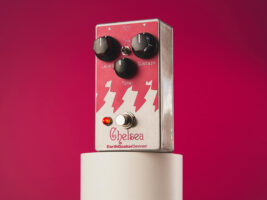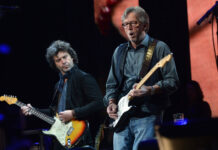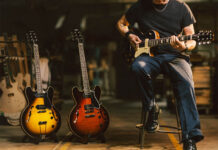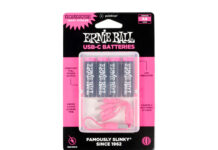
EQD Chelsea Low-End Fuzz Driver review: bass-friendly big muff
$179/£189.99, earthquakerdevices.com
While it might not be the first thing that comes to mind when you think of dance-punk legends LCD Soundsystem, a fuzzed-out bass guitar has still underpinned some of the band’s best tracks. The pedal producing that fuzz happens to be a V6 transistor Big Muff, one purchased by bandleader James Murphy all the way back in 1989. This unit has now found a second life as the Chelsea, a signature recreation of the pedal from EarthQuaker Devices, named after the guitar shop it was purchased in all those years ago.
READ MORE: Chase Bliss Brothers AM review: “it could easily be the last drive pedal you ever buy”
Image: Adam Gasson
What is the EQD Chelsea?
The Chelsea is effectively James Murphy’s version of the Hizumitas. Like with Wata’s own Elk Sustainer, Murphy’s pedal has been toured to almost death and is currently held together with duct tape – and thanks to some drifting 1980s components, it’s also developed a character all of its own. The Chelsea aims to capture it in sonic amber – without the risk of it falling apart or drifting any more.
The V6 transistor Big Muff is one of the variants that featured a tone-bypass switch by default, which EQD has kept here. This allows you to take the dual-filter tone stack out of the circuit completely, meaning a much more midrange-forward sound rather than the classic Big Muff scoop.
As with many of EQD’s recent pedals, the Chelsea features a soft-touch momentary switch for relay true-bypass, and a quick peek inside reveals very little of the actual circuit, thanks to a large daughterboard for the power and audio jacks. The build quality is all correct and proper, with crisp artwork – even if the design itself isn’t too fancy. The pink limited-edition variant is pretty cool, however!
Image: Adam Gasson
The sounds
The Chelsea sounds, well, like a Big Muff – specifically, like a slightly lower-gain vintage one. It’s definitely in the territory of “fuzz” rather than “overdrive” but there’s also not the sort of extreme saturation and razor-sharp mids-scoop that you might expect from pedals like the modern NYC Muff.
The controls function as you’d expect – it is still a Big Muff variant, and so there are not going to be too many surprises. One thing that does stand out is the rather modest output level – at full whack, it only pushes things a touch beyond unity gain. This isn’t totally unheard of for Big Muffs, of course, but if you’re the kind of player that likes your fuzz pedals to completely annihilate your preamp section, you’re going to need a boost too.
Having played and built a good deal of Big Muff circuits over the years, I’ve personally found that lower-gain versions of the circuits tend to be better at letting bass through – the Sovtek Green Russian variant, for example, is a surprisingly low-gain circuit for something that has a rep as a doom monster. But it’s the lower gain that allows for some clarity with basses and down-tuned guitars.
There are other factors, of course, but the principle stays generally true here. Both in terms of the low-end and the pick attack, the Chelsea rumbles with the best of them. Obviously, LCD Soundsystem’s bass fuzz sound never really veers into extremely saturated low-end drones, and so the percussive-yet-gritty thing the Chelsea achieves makes total sense.
Bypassing the tone gives a growling, midrange-forward sound which I tend towards when playing the Chelsea on a six-string. On bass, the midrange scoop I get when leaving the tone stack engaged is great for adding clank in the high-end and thickening up the low end even further. The sweep of the tone control, as you might expect, is as subtle as a brick, ranging from entirely smoothed-off to entirely fizzy.
Unlike a lot of bass-focused fuzzes, there’s no clean blend here; however, I don’t find this to be too much of an issue. The specific circuit being recreated here is clearly more than up to the task of retaining that low-end by itself.
Image: Adam Gasson
Should I buy a Chelsea?
For some bassists, the lack of a clean blend may mean that the Chelsea will never be an always-on proposition, but if you’re the kind of player who wants to add a Big Muff to your bass sound, practicality may not be a priority. The level of clarity that will be offered will also of course depend on the rest of your rig – some bass amps take fuzz better than others!
In any case, though, the Chelsea is a cool circuit variation, and that tone-bypass switch does help it stand out from EHX reissues. However, it is still a chunk of change for a circuit which already has countless variations on the market. Would I recommend it in a vacuum? Absolutely – but it’s worth shopping around unless you really know your Big Muffs!
Chelsea alternatives
I don’t think there’s space on the entire internet to list every Big Muff variant you can buy here, but here are some interesting ones that will scratch the same itch. The Evil Eye FX Warg ($149) is another boutique recreation of a Muff variant that comes with an option for some more midrange. The EHX range of reissues, including the Green Russian, Triangle and Ram’s Head variants, will give you a similar vintage sound with a little more midrange than the modern NYC variant. EQD’s own Hoof V2 ($179/£199) is a cool variant with a lot of grit and bass. And for a final leap down this particular rabbit hole check out Wren And Cuff’s entire lineup.
The post EQD Chelsea Low-End Fuzz Driver review: bass-friendly big muff appeared first on Guitar.com | All Things Guitar.
Source: www.guitar-bass.net











